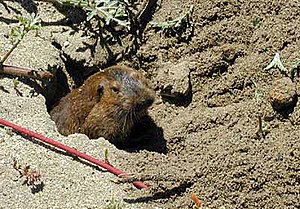Mountain Pocket Rat
| Mountain Pocket Rat | ||||||||||||
|---|---|---|---|---|---|---|---|---|---|---|---|---|

Mountain Pocket Rat |
||||||||||||
| Systematics | ||||||||||||
|
||||||||||||
| Scientific name | ||||||||||||
| Thomomys bottae | ||||||||||||
| Eydoux & Gervais , 1836 |
The mountain pocket rat ( Thomomys bottae ) is a rodent from the family of pocket rats (Geomyidae) living in western North America . It lives mostly underground and feeds on parts of plants that it mainly eats underground. Numerous subspecies have been described.
features
Mountain pocket rats are compact, with a large head, short legs and powerful claws. The animals have a head-to-trunk length of 177 to 267 mm and a tail length of 48 to 85 mm. The coat is of medium length. The color of the fur on the upper side is very variable depending on the distribution and was often used to delimit subspecies. In some populations, the coat color also changes seasonally.
distribution and habitat
The mountain pocket rat lives in the western part of the United States and northern Mexico . It occurs from the south of the state of Oregon to Baja California , east to and including the central Great Basin and south to the plains of northern Mexico. In the USA, the range of the species includes the states of Arizona , California , Colorado and Nevada (possibly extinct there), New Mexico , Oregon, Texas and Utah . In Mexico, the states of Baja California , Chihuahua , Coahuila , Nuevo León , Sinaloa and Zacatecas belong to the distribution area.
The species inhabits different habitats such as open grasslands, prairies , deciduous and coniferous forests and desert-like areas. In these areas it can be found in open terrain with deep soils, and it occurs in agricultural areas.
Way of life
Mountain pocket rats live mostly underground and are territorial loners outside of the mating season. Males have larger territories than females. The animals are diurnal and nocturnal, the main activity time is in the afternoon and early evening.
The animals dig with their large incisors, and the loose earth is cleared aside with their heads or front legs. The construction of a mountain pocket rat usually consists of one or more piles of earth made up of the material obtained from digging, shallow tunnels under the surface of the earth that are used for foraging and deeper areas in which the animals stay permanently. There are pantries and living rooms here. The foraging tunnels run parallel to the soil surface.
nutrition
The mountain pocket rat feeds on a wide range of underground and aboveground plant parts such as roots, tubers, onions, grasses, leaves and cacti, and in winter also on bark. In agricultural areas, the animals also eat field crops.
Reproduction
Pocket rats throw in areas with good food supply all year round and up to four times a year, in the north of the distribution area and at higher altitudes the throwing time is limited to spring. The gestation period is about 18 days. The litters contain 1 to 12 young animals. Females can give birth for the first time in the year of their birth in areas that are environmentally friendly.
Threat and protection
The species is classified by the International Union for Conservation of Nature and Natural Resources (IUCN) as "Least Concern" due to its large distribution area and the size of the population. It is also adaptable and occurs in different habitats; a decline in the population and a greater threat to the species are not known.
In agricultural areas, the mountain pocket rat is considered a pest.
literature
- Cheri A. Jones, Colleen N. Baxter: Thomomys bottae . In: Mammalian Species . No. 742 , 2004, pp. 1–14 ( full text (PDF; 651 kB)).
supporting documents
- ↑ a b c d e f Cheri A. Jones, Colleen N. Baxter: Thomomys bottae . In: Mammalian Species . No. 742 , 2004, pp. 1–14 ( full text (PDF; 651 kB)).
- ↑ a b c d Thomomys bottae in the Red List of Threatened Species of the IUCN 2011. Posted by: AV Linzey, R. Timm, ST Álvarez-Castañeda, T. Lacher, 2008. Accessed January 8, 2012.
Web links
- Thomomys bottae in the Red List of Threatened Species of the IUCN 2011. Posted by: AV Linzey, R. Timm, ST-Álvarez Castañeda, T. Lacher, 2008. Accessed January 8, 2012th

